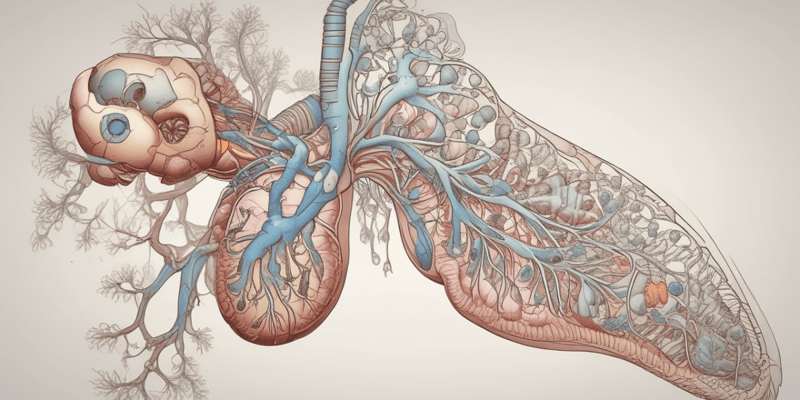20 Questions
What is the primary function of the ductus arteriosus during fetal development?
To shunt blood from the pulmonary artery directly to the aortic arch
What is the primary characteristic of type I pneumocytes?
They are basic simple squamous epithelial cells that comprise 90% of the alveolus
During which stage of fetal lung development do the respiratory bronchioles develop?
Canalicular stage
What is the primary function of surfactant in the alveoli?
To reduce the surface tension of the alveoli
What is the prognosis for babies born during the canalicular stage of fetal lung development?
Generally poor, with a low survival rate
What is the characteristic of surfactant that allows it to bind to both water and air within the alveoli?
Amphipathic properties
During which stage of fetal lung development do the alveoli begin to develop?
Terminal sac stage
What is the primary function of type II pneumocytes?
To produce surfactant
Why are the lungs unable to oxygenate blood during fetal development?
Because there are no alveoli
What is the effect of surfactant on the surface tension of the alveoli?
It reduces the surface tension
What is the primary function of the conducting portion of the respiratory system?
To convey, moisten, and warm the air
What is the name of the structure that separates the respiratory diverticulum from the foregut?
Tracheoesophageal septum
During which stage of development do bronchiolar buds branch off from the tertiary bronchi?
Pseudoglandular stage
What is the embryonic structure that gives rise to the respiratory system?
Primitive gut tube
What is the term for the out-pocketing that appears in the proximal part of the primitive gut tube?
Respiratory diverticulum
What is the term for the portion of the respiratory system that includes the trachea, bronchi, and bronchioles?
Lower respiratory system
During which week of development does the respiratory diverticulum appear?
Week 4
What is the term for the segments that will become specific portions of the lung?
Bronchopulmonary segments
What is the term for the process by which the embryo undergoes lateral folding to form the gut tube?
Lateral folding
What is the clinical correlation of premature birth in relation to respiratory development?
Increased risk of respiratory distress
Study Notes
Respiratory System Function
- Divided into two parts: conducting portion and respiratory portion
- Conducting portion conveys, moistens, and warms the air from outside the body to the lungs
- Exchange of gas occurs at the respiratory portion
Respiratory System Structure
- Divided into upper and lower respiratory tracts/systems
- Upper respiratory system consists of nasal cavity, oral cavity, pharynx, and associated structures
- Lower respiratory system consists of trachea, bronchi, bronchioles, and alveoli
Development of Respiratory System
- Derived from the primitive gut tube, precursor to the gastrointestinal tract
- Gut tube is an endodermal structure formed during early embryonic period
- Respiratory diverticulum appears in the proximal part of the primitive gut tube at week 4 of development
- Respiratory diverticulum bifurcates into two buds, which become the left and right primary bronchi
Pseudoglandular Stage (Weeks 8-16)
- Each bronchopulmonary segment becomes a specific portion of the lung, carrying its own tertiary bronchus and branches of the bronchial and pulmonary arteries
- Ducts develop within bronchopulmonary segments
- Bronchiolar buds branch off from the tertiary bronchi and begin to proliferate
- No gas exchange occurs at this stage due to the absence of alveoli
Canalicular Stage (Weeks 16-26)
- Respiratory bronchioles develop, budding off from the terminal bronchioles
- No gas exchange membrane, and lungs are not yet functional
- Prognosis for babies born during this stage is not high
Terminal Sac Stage (Week 26 onwards)
- Alveoli develop, with two types of cells: Type I and Type II pneumocytes
- Type I pneumocytes are basic simple squamous epithelial cells (90% of alveolus)
- Type II pneumocytes are simple cuboidal cells (10% of alveolus) responsible for producing surfactant
- Surfactant is amphipathic, reducing surface tension and allowing alveoli to expand with minimal effort
Learn about the functions and structural divisions of the respiratory system, including the conducting and respiratory portions, upper and lower tracts, and their roles in gas exchange.
Make Your Own Quizzes and Flashcards
Convert your notes into interactive study material.
Get started for free



